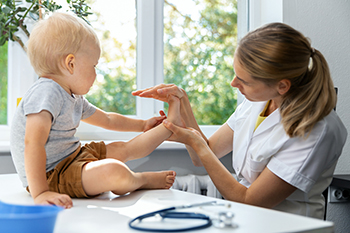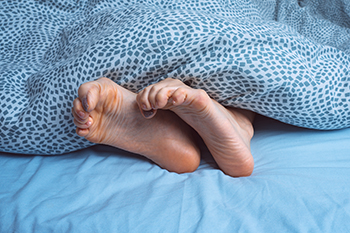1648 US Highway 130
North Brunswick, NJ 08902

Most people are familiar with bunions, but another toe deformity that can become uncomfortable, or even painful, is claw toe. The tip of the toe curls underneath the foot, while the base of the toe rises up. This usually occurs in one or more of the smaller toes. Although claw toe can be a sign of diabetes, it may also be the result of shoe type, foot structure, or some type of trauma. Besides improperly fitting shoes or other footwear, the causes of claw toe may include ankle injuries, inflammation, or swelling of the feet. In addition, nerve damage that weakens the muscles in the feet may be a factor. Certain underlying medical conditions, including rheumatoid arthritis, cerebral palsy, and diabetes have been identified as possible factors in the development of claw toe. The risk of claw toe increases with age. If you have noticed a change in the structure of your toes or are experiencing unusual pain in the toes, it is suggested that you consult with a podiatrist who can conduct an examination, offer a diagnosis, and suggest a possible treatment plan.
Toe pain can disrupt your daily activities. If you have any concerns, contact Dr. Robert Fink of Brunswick Foot & Ankle Group. Our doctor can provide the care you need to keep you pain-free and on your feet.
What Causes Toe Pain?
Most severe toe pain is caused due to a sports injury, trauma from dropping something heavy on the toe, or bumping into something rigid. Other problems can develop over time for various reasons.
Toe pain can be caused by one or more ailments. The most common include:
When to See a Podiatrist
Diagnosis
In many cases the cause of toe pain is obvious, but in others, a podiatrist may want to use more advanced methods to determine the problem. These can range from simple visual inspections and sensation tests to X-rays and MRI scans. Prior medical history, family medical history, and any recent physical traumatic events will all be taken into consideration for a proper diagnosis.
Treatment
Treatments for toe pain and injuries vary and may include shoe inserts, padding, taping, medicines, injections, and in some cases, surgery. If you believe that you have broken a toe, please see a podiatrist as soon as possible.
If you have any questions please feel free to contact our office located in North Brunswick, NJ . We offer the newest diagnostic tools and technology to treat your foot and ankle needs.

The foot has 26 bones, and numerous tendons and ligaments. An infant’s feet are made of soft cartilage, and wearing shoes and socks that fit correctly can help to maintain their natural shape. It is interesting to know that a child’s foot will grow to approximately half of their adult foot size in the first year, making it an important developmental stage. A good foot care routine for your child can start with washing and drying their feet thoroughly. Trimming the toenails regularly is important, and parents should follow the line of the toenail and refrain from cutting them too short. Many parents choose to have their children walk barefoot while indoors, and this may be beneficial in strengthening the overall foot. When it is time to purchase shoes when walking is done outdoors, it is helpful to choose shoes that are supportive. If you have questions about your child’s foot development, it is suggested that you confer with a podiatrist who can address any concerns you may have.
The health of a child’s feet is vital to their overall well-being. If you have any questions regarding foot health, contact Dr. Robert Fink of Brunswick Foot & Ankle Group. Our doctor can provide the care you need to keep you pain-free and on your feet.
Tips for Keeping Children's Feet Healthy
If you have any questions, please feel free to contact our office located in North Brunswick, NJ . We offer the newest diagnostic and treatment technologies for all your foot care needs.

One of the best ways to care for your feet is by wearing shoes that can prevent foot problems and ease pain. It’s also important to find shoes that help reduce the chances of falling. Three main factors to consider when choosing footwear are activities, surfaces, and support. If you spend a great deal of time standing or running on hard surfaces, look for shoes with softer soles and insoles, as well as ample arch support. For ankle support and stability, lace-up boots are a good idea, with proper padding in the tongue and around the heel. Wearing the proper shoes for whatever activity you are doing, can be a big help in avoiding injuries. People with foot or toe deformities, such as bunions or hammertoes, may need wider shoes with a higher toe box to prevent calluses and corns. For more information on finding the proper shoe for your feet, it is suggested that you consult a podiatrist.
It is important to find shoes that fit you properly in order to avoid a variety of different foot problems. For more information about treatment, contact Dr. Robert Fink from Brunswick Foot & Ankle Group. Our doctor will treat your foot and ankle needs.
Proper Shoe Fitting
Shoes have many different functions. They cushion our body weight, protect our feet, and allow us to safely play sports. You should always make sure that the shoes you wear fit you properly in order to avoid injuries and deformities such as: bunions, corns, calluses, hammertoes, plantar fasciitis, stress fractures, and more. It is important to note that although a certain pair of shoes might be a great fit for someone else, that doesn’t mean they will be a great fit for you. This is why you should always try on shoes before buying them to make sure they are worth the investment. Typically, shoes need to be replaced ever six months to one year of regular use.
Tips for Proper Shoe Fitting
The shoes you buy should always feel as good as they look. Shoes that fit properly will last longer, feel better, and improve your way of life each day.
If you have any questions, please feel free to contact our office located in North Brunswick, NJ . We offer the newest diagnostic and treatment technologies for all your foot care needs.

Waking up in the middle of the night with a foot cramp can be disturbing to sleep, as well as painful. Foot and toe cramps, which are muscle spasms, can have several causes among them are dehydration, vitamin deficiency, and circulation problems. Drinking more water during the day can help to keep the body hydrated. If foot and toe cramps are common, it pays to keep track of the intake of certain vitamins and minerals. Calcium, potassium, magnesium, and salt can impede the muscles’ ability to contract and release. Too little time spent stretching can contribute to tight muscles, which may result in cramping. Poor circulation, which may take the form of peripheral artery disease, can be a factor in foot cramps. Wearing shoes that are uncomfortable or ill-fitting also can result in cramping of the feet and toes. Women may be more susceptible after wearing high heels with a pointy toe box. Certain medications, such as diuretics and cholesterol medicine, may cause cramping. And medical conditions, such as pregnancy, diabetes, and peripheral neuropathy may also be risk factors. If you notice that foot and toe cramps have become more common, it is suggested that you consult a podiatrist for more information.
Foot Pain
Foot pain can be extremely painful and debilitating. If you have a foot pain, consult with Dr. Robert Fink from Brunswick Foot & Ankle Group. Our doctor will assess your condition and provide you with quality foot and ankle treatment.
Causes
Foot pain is a very broad condition that could be caused by one or more ailments. The most common include:
Diagnosis
To figure out the cause of foot pain, podiatrists utilize several different methods. This can range from simple visual inspections and sensation tests to X-rays and MRI scans. Prior medical history, family medical history, and any recent physical traumatic events will all be taken into consideration for a proper diagnosis.
Treatment
Treatment depends upon the cause of the foot pain. Whether it is resting, staying off the foot, or having surgery; podiatrists have a number of treatment options available for foot pain.
If you have any questions, please feel free to contact our office located in North Brunswick, NJ . We offer the newest diagnostic and treatment technologies for all your foot care needs.